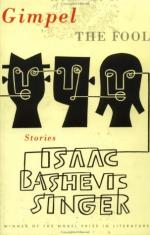|
This section contains 304 words (approx. 1 page at 400 words per page) |

|
Critical reaction to "Gimpel the Fool" has been positive ever since the story first appeared in translation in the Partisan Review in 1953. It was "Gimpel the Fool," along with the translated novel The Family Moskat (1950), that first brought Singer to the attention of American reading audiences. The story has been called a masterpiece of short fiction and has been praised for its depiction of Jewish life; its emphasis on spirituality, faith, and morality; its sympathetic portrayal of ordinary people; and its examination of universal themes. Alfred Kazin, writing in his Contemporaries, stated that "it is the integrity of the human imagination that Singer conveys so beautifully," while Paul N. Siegel noted in The Achievement of Isaac Bashevis Singer that Gimpel "has become representative of poor, bewildered, suffering humanity." Cynthia Ozick also praised Singer's talents in The New York Times Book Review: "[Singer's] tenderness for ordinary folk...
|
This section contains 304 words (approx. 1 page at 400 words per page) |

|




